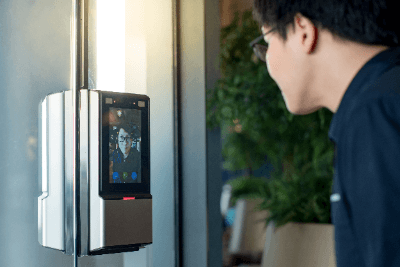What Is a Facial Recognition System?
 A facial recognition system is a technology that authenticates individuals based on their facial features. It is among the various biometric authentication systems that also use fingerprints, iris scans, and voice recognition.
A facial recognition system is a technology that authenticates individuals based on their facial features. It is among the various biometric authentication systems that also use fingerprints, iris scans, and voice recognition.
In the past, there were some issues with authentication accuracy, such as failing to recognize individuals with different hairstyles or hair colors. However, recent advancements have significantly improved accuracy, making it a highly secure system.
Due to these improvements, the adoption of facial recognition systems has increased, especially as a hygiene-focused measure against infectious diseases, since they do not require physical contact for authentication.
Uses of Facial Recognition Systems
1. Access Control at Office Entrances and Exits, Non-contact Authentication (Infectious Disease Countermeasure)
Facial recognition systems installed at office entrances and exits, linked to electronic locks and pre-registered employee photos, allow for keyless and cardless access control. Some systems also maintain logs of entry and exit.
Since the access key is not a physical object, it cannot be lost, making facial recognition systems highly effective against identity theft. Their non-contact nature also enhances hygiene in entering or exiting areas.
2. Monitoring in Nursing Care Facilities
These systems can monitor entrances and exits of nursing care facilities to ensure residents do not leave unexpectedly. Pre-registering residents’ photos enables the system to distinguish between residents, staff, and visitors.
Beyond these examples, facial recognition systems can be integrated with various types of systems and equipment for:
- Temperature detection of registered individuals
- Countermeasures against unauthorized persons
Linking facial recognition with other systems and devices can broaden its applications.
Principle of Facial Recognition Systems
Facial recognition systems identify facial features such as the eyes, nose, mouth, and contours from an image, comparing them to a database of pre-registered faces to verify identity.
Advanced systems often employ AI deep learning, enhancing accuracy through continuous learning from facial authentication data.
Considerations When Using Facial Recognition Systems
1. Regarding False Identification
Despite their high security, facial recognition systems are not infallible. Increasing the matching threshold with pre-registered photos can enhance security but may also slow down authentication and struggle with minor facial changes, like wearing glasses.
Incorporating multiple photos per individual can improve accuracy. For enhanced security at entry and exit points, combining facial recognition with other methods, like card authentication or keys, is advisable.
2. Concerning Privacy
Facial recognition data and images are personal information. Obtaining consent is essential when using these systems in corporate settings.
When deployed in public spaces like stores, it’s crucial to inform the public about the data collection from facial recognition, clearly state the purpose, and ensure data is used minimally and specifically for that purpose. Establishing and adhering to clear internal guidelines for data handling and registration criteria is also important.